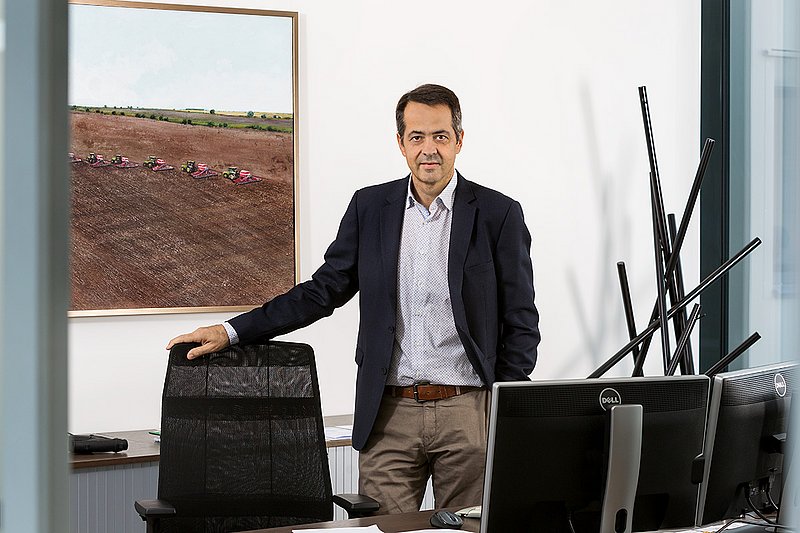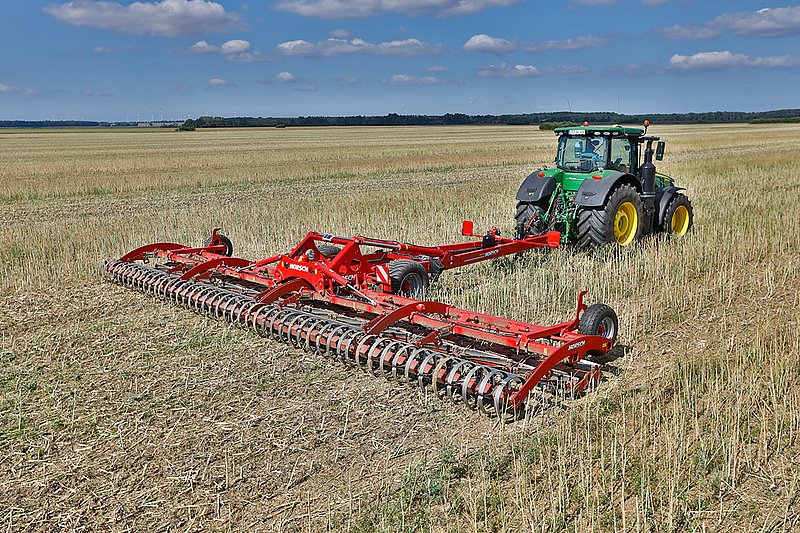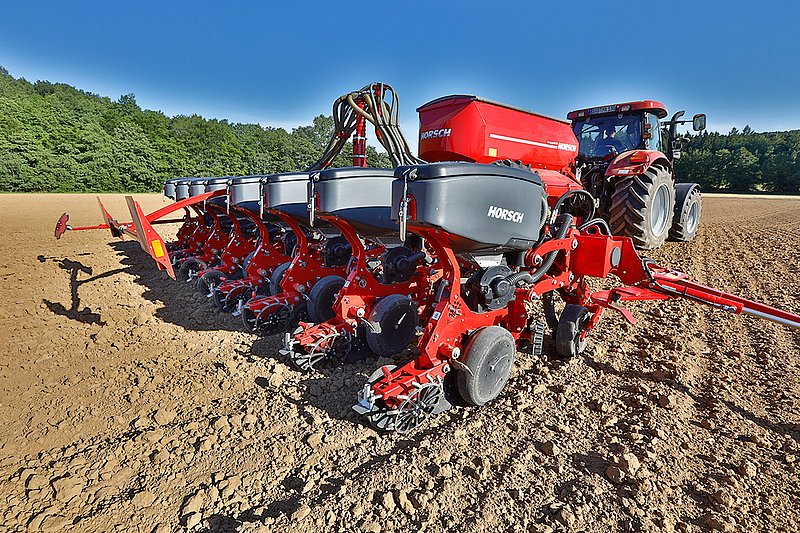New developments will secure our future
Within the scope of the Agritechnica 2019 HORSCH presents an explosion of innovations. Philipp Horsch does not only talk about the most important innovations in tillage and sowing, but also about topics from the sectors electronics and digitisation. This year, a special focus is on the latter.

terraHORSCH: HORSCH intensely pushes the developments in the sectors digitisation and connectivity. What is your idea behind it?
Philipp Horsch: Today, agriculture and we as a manufacturer of agricultural machinery have to face a lot of challenges: environment protection, climate protection, food production – all this has to do with agriculture and is inseparably linked with each other. In my opinion, these global topics cannot be solved without the aid of digitisation. This is the reason why the focus of our current developments is on this topic.
We have already been working on the topic of connectivity for some years and there have been some mis-developments in this sector that had to be stopped. The main objective is to create a connection between machine and internet for all our machines with job computers. On this basis, we parallelly already develop the first applications to reproduce the most different use cases that will make it easier for the farmer to work with our machines. HorschConnect allows for exactly this linking and provides the necessary interfaces. With the SmartCan module we offer a hardware solution that in addition to the connection between the machine and the internet also establishes a WLAN-based local network from the smartphone to the machine.

Will there be a special HORSCH app to control these applications?
Philipp Horsch: Yes, there will be such an app. Under the name “MobileControl“ we combine most different functions and applications. The focus is always on the customer’s benefit and the reduction of the workload of the farmer. MobileControl for example allows for a simple calibration of a HORSCH seed drill. The farmer carries out all necessary adjustments directly in the app on his smartphone or tablet while he stands right beside the seed drill. He does no longer have to climb into the tractor cabin to enter values at the terminal. This is particularly helpful for seed drills with several components resp. metering devices.
For the HORSCH Maestro MobileControl offers one feature: the possibility to carry out single row tests directly at the seed unit. With regard to our plant protection technology it is already possible to carry out nozzle tests via smartphone. And we are working on many more topics. Thus, there will be a variegated bunch of functionalities that will help the farmer to save time and to make his life easier.

Which opportunities do you see for the future due to an increasing degree of connectivity?
Philipp Horsch: HorschConnect – similar to all our developments – is about the maximum benefit for the farmer and his work! A central topic is data management and the careful handling of data. The connection of the machine to the internet enables the customer to share his data with partners he can select and define himself, for example via independent third-party systems like the agrirouter.
In this respect, I would also like to mention the topic SupportView. With this system, it will be possible to transfer the screen views the driver sees on his terminal to mobile devices or directly to a PC in the office.
The farmer, thus, is provided with completely new opportunities. If he for example shares his terminal view with the responsible service partner or with a HORSCH service technician, they can support him quite easily with regard to adjustment and optimisation of his machine.
The whole range of connectivity and the reasonable collection of machine data, however, offers even more opportunities and services to our customer: Predictive Maintenance will assist us in the future to maintain our machines in a proactive way and, thus, to keep potential downtimes as low as possible.
What can you tell us about the I-Manager?
Philipp Horsch: On the hardware as well as on the software side the I-Manager is a new generation of our ISOBUS operating systems that we will launch successively. It is based on the intuitive operating logic of the HORSCH Leeb plant protection technology that now has been optimised for and adapted to the sowing technology.
The objective was to develop a reliable and especially expandable software that disposes of a lot of new and innovative functions to make adjustment, handling and monitoring of the technology easier for the farmer.
Today seed drills apply several components with several metering devices in several sections. A scalable and configurable software is a must-have! With the I-Manager software-related restrictions and compromises with regard to the variety of versions and equipment options are a thing of the past. Moreover, the combination with RowControl allows for a freely configurable tramline rhythm.
In the software and operating management sector it finally all is about responding even faster and more precisely to the requirements of our customers. In the future, the drivers configure the display of their terminal interface according to their individual preferences.
Another objective of this development is to include even more redundancy, that is multiple safeguards, as well as fully diagnoseable systems in all sectors of sowing technology to guarantee utmost operational reliability of our machines.
What are the latest developments in the sector of automatic coulter pressure regulation for standard seed drills?
Philipp Horsch: After our excellent experiences with our AutoForce technology in the HORSCH Maestro single grain seed drills with regard to the placement quality, we have been focussing for quite some time on automating and rendering the seed placement for our standard seed drills more precisely especially in heavily changing soils. On the lines of AutoForce for the Maestro an automated regulation is to make sure that the pre-set load on the depth control wheel is kept constant no matter if the soils are heavy or light. Currently, we are carrying out the first practical tests with the Serto that, being a solo seed drill without front tools, is ideal for this technology.
With the TurboDisc 3 a new generation of the seed coulter will be launched for the HORSCH Pronto. What has been changed?
Philipp Horsch: First off: The TurboDisc coulter has not been revised because of the mechanics, the costs or the stability. The only objective of this further development was to even better cope with adverse, wet and adhesive soil conditions.
Growing farms require more and more efficiency and sometimes have to sow even if the conditions are not optimum. This is where again our top priority comes in – maximum operational reliability of the machine and thus highest possible benefit for the customer! The TurboDisc 3 coulter with its adaptions in the area of the fall tube and the scraper allows the farmer to work even in most difficult conditions with cohesive soils with even less cloggings.
Today, agriculture and we as a manufacturer of agricultural machinery have to face a lot of challenges: environment protection, climate protection, food production.
What can you tell us about the new disc harrow Joker RT?
Philipp Horsch: Insights and developments go on and on and thus, for us, it is a normal, recurrent process to revise our products at regular intervals. It is especially important for us to react to the changing requirements of the market and especially, to act on the feedback of our customers and include all this in the new generation of a machine. Such further developments of a product at first always sound easier than they really are. And for the Joker RT the update, this time, has been a little bit more comprehensive.
We put a special focus on becoming even more variable with regard to equipment options and combinations. In addition to different double packers, the RT will now also be available with selected single packer systems. Moreover, both versions can be equipped with front tools like knife roller or Crossbar according to the customers’ requirements.
We also dealt intensely with the contact area when working which is particularly difficult to realise for disc harrows. We managed to leave a considerably more level and cleaner work result with different working depths and on different soil conditions – with a minimum adjustment effort.
The new Joker generation, thus, offers a number of new features and even some more effective working width – and all that at the same price as the previous model (with comparable equipment).
If you follow the product developments of the past years in the seed drill sector, you notice that the trend clearly is towards multiple component systems. Is this the reason why the HORSCH Focus now is also available with a MiniDrill?
Philipp Horsch: Cultivation methods and rotations in modern farming change constantly and are permanently developed further. Under sown respectively double seed are only two keywords that have to be mentioned in this respect. Moreover, to increase efficiency, farmers want to combine more and more work steps in one pass and for example apply seed and fertiliser together. Therefore, the demand for multiple tank systems is present. Especially in our export markets this is an important topic. This is why, for years, we have been developing our seed drills in this direction and by doing so we hit the spirit of the age. To additionally equip our Focus with a MiniDrill and thus be able to apply one more component, is a further step to act even more specifically with regard to the requirements and in a more customised way.
In the tillage sector the HORSCH Cultro is shown for the first time at the Agritechnica. Why does HORSCH develop such a special machine?
Philipp Horsch: In future farming, shallow tillage will play a central role for the most different reasons. Therefore, it is important for us to become more and more specific in this sector with a variegated range of machines and to be able to adapt even more precisely to the varying requirements.
Let me take the example of the HORSCH Cruiser to explain this: In our opinion, the range of use of the Cruiser at the moment is for shallow and medium-deep tillage. At customer’s option, it can be equipped with a different number of bars and thus with different tine spacings. Moreover, we have a wide range of coulter versions and can provide the appropriate tools for all conditions.
To cope with the constantly increasing meaning of shallow tillage in the future respectively to allow for an even shallower tillage, we, in addition to the HORSCH Finer, also developed the HORSCH Cultro – and the Cultro can work in an even more shallow way.
It, thus, can carry out rather special tasks in the tillage sector – among them for example the crushing of organic material and harvest residues after rape, sunflower or maize harvest respectively the rolling of catch crops. The two knife rollers crush, crimp and cut the growth and thus encourage the rotting process.
There are also innovations in the Maestro sector: Maestro CV and RV respectively Maestro CX and RX. Why does HORSCH now work on an overpressure metering system in addition to the vacuum system?
Philipp Horsch: Our Maestros work in all parts of the world. Farmers sow the most different crops and work in the most different conditions. Thus, the requirements on the machines they use are manifold.
Whether vacuum or shot metering – both systems work and both systems have advantages in certain working conditions. Overpressure systems, for example, allow for higher operational speeds while the placement quality remains the same. On the other hand, they cannot handle all seeds of this world or they reach their limits of use in particularly wet and adhesive soil conditions because the use of catching rollers is indispensable. This is where vacuum systems have their advantages and can score with the mentioned topics. So we clearly see a long-term demand for both technologies!
The objective of our developments is to help shape the future of agriculture.

How does such a development proceed and what are the new features of the Maestro?
Philipp Horsch: We laid the basis by revising the body completely. And we tackled several topics at the same time.
The focus is on the metering body. We will launch a new generation of vacuum technology – the so-called AirVac metering device for the Maestro CV and Maestro RV. The two newly developed lines Maestro CX and Maestro RX will be equipped with the AirSpeed metering device and thus, work according to the principle of overpressure. In total, both systems are based on the same singulation technology and mostly also on the same design respectively the same components.
An essential highlight is a new singulation system to strip off doubles at the metering discs: a merely mechanical system is used that does no longer require any adjustment with regard to different grain shapes and sizes within one type of seed – a significant simplification and thus an enormous benefit for the customer.
We also made some changes at the row. Our customers require smaller row spacings to be able to sow even more different crops with the Maestro. Therefore, we will offer row spacings of 35 cm in the future. 35 cm are ideal for Eastern Europe where currently 70 cm is a common spacing for maize, sunflowers or soybeans.
With regard to the working tools in front of or behind the seed coulter we also pushed some further developments among others for the placement of fertiliser or the cultivation of the furrow. Thus, in the future, we are able to adapt our machines even more individually to the farm-specific requirements of our customers.
In addition to all the mechanical modifications we also reviewed the whole electronic architecture and prepared it for the challenges of the future. The most important innovation has been carried out in the hardware sector. New cablings and controls of the individual rows as well as fully integrated diagnostic systems are only some of the keywords in this context.
All things considered, the top priority of this revision was on the greatest possible usability for the farmer and the driver. That is, the handling has been simplified to the greatest possible extent.
One of the most important HORSCH machines is the cultivator Terrano. Are there any innovations for this line?
Philipp Horsch: For the Terrano we extended the point system to be able to bring shallow cutting to perfection. In this sector, we are investing a lot of capacity and energy at the moment. After all, the perfect shallow cutting is the basic requirement to satisfy the social request for using less herbicides.
In this context, a lot of farmers ask themselves: “How can we succeed in managing grass-clover turnings or GPS turnings without losing too much water?“. The answer is: shallow cutting with a solid tine and a sliding cut.
The Terrano with its TerraGrip tines provides the optimum conditions. Customers who already work with a Terrano can “upgrade” their existing machine in an easy and cost-efficient way without having to dig deep into their pockets.